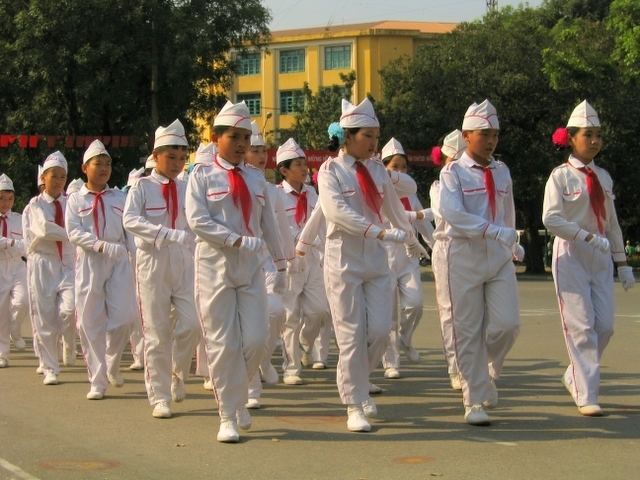A pioneer movement is an organization for children operated by a communist party. Typically children enter into the organization in elementary school and continue until adolescence. The adolescents then typically join the Young Communist League. Prior to the 1990s there was a wide cooperation between pioneer and similar movements of about 30 countries, coordinated by the international organization, International Committee of Children's and Adolescents' Movements (French: Comité international des mouvements d'enfants et d'adolescents, CIMEA), founded in 1958, with headquarters in Budapest.
Pioneer movements exist in countries where the Communist Party is in power as well as in some countries where the Communist Party is in opposition, if the party is large enough to support a children's organization. In countries ruled by Communist Parties, membership of the pioneer movement is officially optional. However, membership provides many benefits, so the vast majority of children typically join the movement (although at different ages). During the existence of the Soviet Union, thousands of Young Pioneer camps and Young Pioneer Palaces were built exclusively for Young Pioneers, which were free of charge, sponsored by the government and trade unions. There were many newspapers and magazines published for Young Pioneers in millions of copies.
The Pioneer movement was modeled on the Scout movement, but there are some distinct differences. Most notably, the Scout movement is independent of government control and political parties. Some features, however, are reminiscent of the Scout movement. The two movements share some principles like preparedness and promotion of sports and outdoor skills. The pioneer movement also includes teaching of communist principles. Opponents of Communist states claim that this is a form of indoctrination.
A member of the movement is known as a pioneer, and a kerchief or necktie — typically red, but sometimes light blue — is the traditional item of clothing worn by a pioneer. The pioneer organization is often named after a famous party member that is considered a suitable role model for young communists. In the Soviet Union it was Vladimir Lenin; in East Germany, it was Ernst Thälmann. The Thälmann pioneers were taught the slogan "Ernst Thälmann is my role model. We wear our red scarf with pride." Albania, which severed diplomatic relations with the USSR in 1961, also had a variant of Pioneer organization, called Pioneers of Enver, named after the communist ruler of Albania, Enver Hoxha.
The Pioneer Movement now exists in these countries:
Armenia (Republic of Young Pioneers and Lernamerdz Soviet Pioneers)Belarus (Belarusian Republican Pioneer Organization)Belgium (Pioneers of the Workers Party of Belgium)People's Republic of China (Young Pioneers of China)Cuba (José Martí Pioneer Organization) Established in 1961; in 2001 it was elected to the Global 500 Roll of Honour of the United Nations Environment Programme for its environmental activities.Cyprus (EDON)Finland - Democratic Union of Finnish Pioneers (Pinskut)The Czech Republic – Nowadays Pionýr is a non-political organisation organizing leisure time for children, part of the IFM-SEI.HungaryLaos; the Young Pioneers in Laos are under the Lao People's Revolutionary Youth Union (LPRYU).Mexico (Pioneers Association "Vicente Lombardo Toledano" of the Partido Popular Socialista)North Korea (Young Pioneer Corps of the Korean Children's Union)Portugal – Pioneiros de Portugal (founded in 1974), connected to the Portuguese Communist Party.Russia – (Pioneers of the Communist Party of the Russian Federation)Moldova – (Pioneers of the Party of Communists of the Republic of Moldova)Ukraine – (Pioneers of the Communist Party of Ukraine)Senegal – Mouvement Nationale des Pionniers SenegaleseSpain (Pioneers of the Communist Party of the Basque Homelands)Syria (Baath Party Pioneers)Tajikistan (King Somoni Inheritance)Vietnam (Ho Chi Minh Young Pioneer Organization, established on May 15, 1941)Older children could continue in other communist organizations, but that would typically be done only by a limited number of people.
The communist parties in Russia and other countries continue to run a pioneer organization, but membership tends to be quite limited.
Soviet Union (USSR) – Vladimir Lenin All-Union Pioneer OrganizationSocialist People's Republic of Albania – Pioneers of Enver – Pioneers of Enver HoxhaPeople's Republic of Bulgaria – Dimitrovist Pioneer Organization "Septemberists". There were also an organization called chavdarcheta – these were the youngest children, which later became pioneers. The difference between the two was the distinctive scarf, which was sky-blue in the chavdarcheta movement and red in the pioneri movement.Socialist Republic of the Union of Burma – Lansin Lu-nge (literally Programme Youth) – it was an organisation for smart high school students and university students to enter and learn about friendship, useful skills and of the socialist politics of the Burma Socialist Programme Party.People's Republic of Kampuchea. The Young Pioneers in Cambodia between 1979 and 1993 were under the Kampuchean Revolutionary Youth Association (KRYA) and the Kampuchean Young Pioneers Organization (KYPO), branches of the Kampuchean United Front for National Salvation.Czechoslovak Socialist Republic – Pioneer Organization of the Socialist Youth Union, part of the Socialist Youth Union.German Democratic Republic – Ernst Thälmann Pioneer OrganisationPeople's Republic of Hungary – ÚttörőszövetségIndonesia – Fadjar HarapanRepublic of Malawi – Malawi Youth Pioneers – this is atypical as Malawi was not a communist country. Its Pioneers were linked to the Malawi Congress Party, the only political party allowed in what was at the time a one-party state.Republic of Mali – Young Pioneers (Mali)/Jeunes Pionniers (1960–?), Socialist youth brigades established by the US-RDA of Modibo Keïta.Republic of Niger – Young Pioneers (Niger)/Jeunes Pionniers (1961–1974) non-communist youth paramilitary group, one of several set up in post independence Africa, funded by and modeled on the Israeli Nahal ("Fighting Pioneer Youth").Republic of Upper Volta / Burkina Faso – Pioneers of the Revolution, the youth movement of Thomas Sankara and the Council of Popular Salvation.Kingdom of Norway – Young PioneersPeople's Republic of Poland – 1950–1956, later Związek Harcerstwa Polskiego, a mixture of Scouting and pioneeringSocialist Republic of Romania – Pioneer OrganizationSocialist Federal Republic of Yugoslavia – Union of Pioneers of Yugoslavia (Pioniri)United States – Young Pioneers of America (1922-1934)
